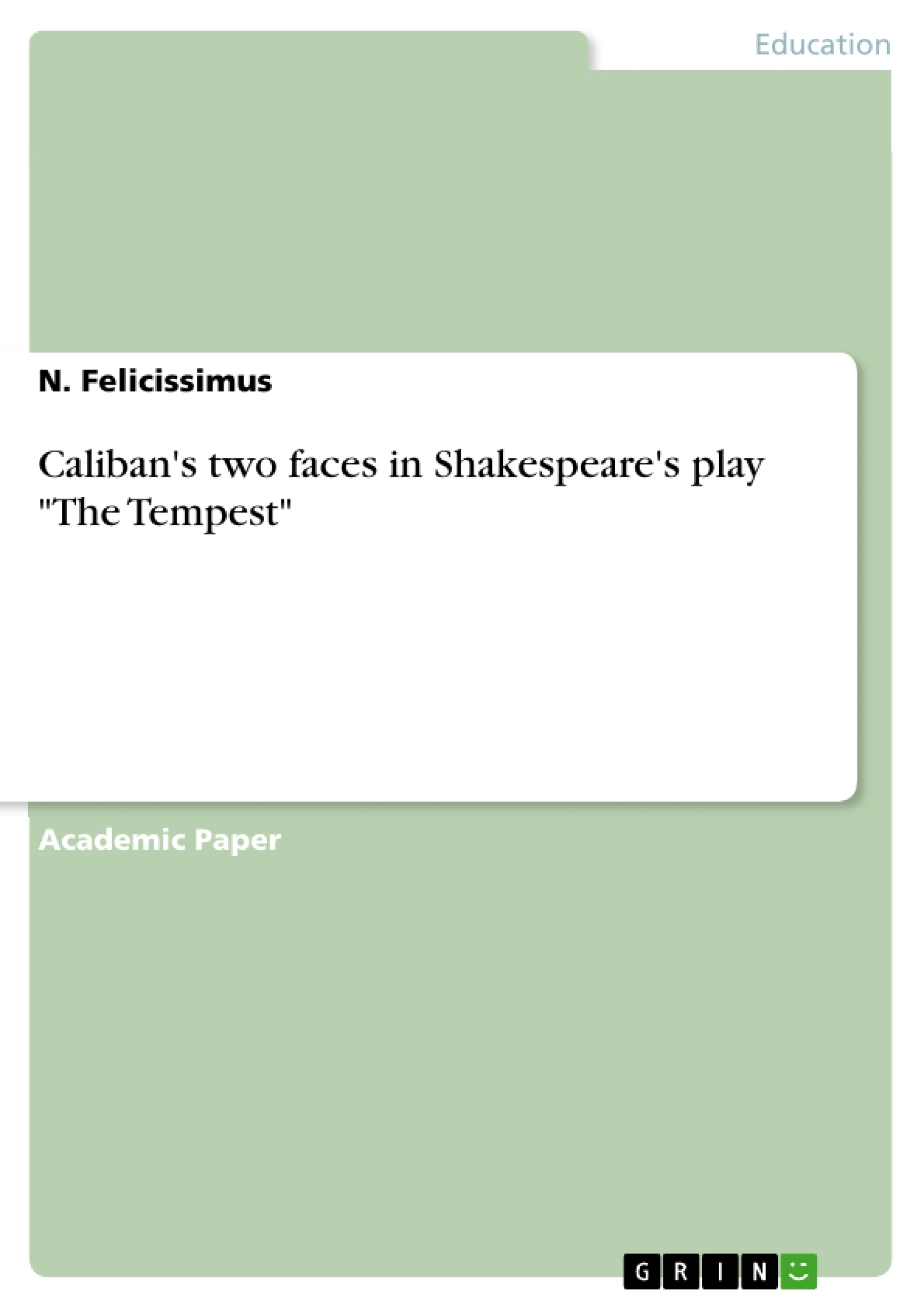“A savage and deformed slave.” Shakespeare uses exactly these words to describe the figure of Caliban in the dramatis personæ of his play "The Tempest". For almost four centuries, literary critics have dealt with trying to answer the question how Shakespeare’s character has to be regarded. Is Caliban to be considered as a monster representing humanity’s bestial side including all its vices, and thereby arousing the audience’s disgust? Or has he rather to be looked at as the victim of an imperial tyrant – personified by Prospero – who arouses the spectator’s pity?
Among Shakespeare’s stage characters, Caliban has been interpreted in many different ways. He has been represented in theatre and in literary criticism as a fish, a tortoise, an American Indian, and an African slave. He is said to be one of the most abstract and wildest characters in Shakespeare’s plays.
Table of Contents
- 1 Introduction
- 2 Caliban the beast
- 3 Caliban the noble savage
- 4 Conclusion
Objectives and Key Themes
This paper aims to explore the dual nature of Caliban in Shakespeare's The Tempest, examining the conflicting interpretations of him as both a beast and a noble savage. It investigates how these representations have evolved over time, influenced by different theatrical adaptations and critical perspectives.
- Caliban's portrayal as a monstrous figure driven by base instincts.
- The impact of theatrical adaptations on Caliban's image.
- The concept of the "noble savage" and its application to Caliban.
- The exploration of Caliban's potential for education and civilization.
- Caliban's relationship with Prospero and its implications.
Chapter Summaries
1 Introduction: This introductory chapter sets the stage for the analysis of Caliban's complex character in Shakespeare's The Tempest. It establishes the central question of whether Caliban should be viewed as a monstrous beast or a noble savage, highlighting the diverse interpretations that have emerged over centuries. The chapter introduces the methodology, emphasizing the examination of both the original Shakespearean text and relevant scholarly perspectives, alongside cultural background, to support a nuanced understanding of Caliban’s dual nature. The approach will involve a close reading of select passages within the play, complemented by referencing key scholarly positions, and notably Montaigne's "Of Cannibals," which significantly influences the discussion of "noble savagery."
2 Caliban the beast: This chapter delves into the portrayal of Caliban as a "beast," examining various interpretations and textual evidence. It acknowledges the limited knowledge of early performances of The Tempest and focuses instead on the significant alterations made in the Restoration Era adaptation by Davenant and Dryden. This version introduced Hippolito, a character contrasting sharply with Caliban, highlighting the prevailing image of Caliban as an uneducable, monstrous savage. The chapter then turns to the original Shakespearean text, citing numerous passages and critical analyses that portray Caliban through pejorative terms, linking him repeatedly to the word "monster." His attempted rape of Miranda, his plotting against Prospero, and the general depiction of his actions and motivations all contribute to this interpretation. The chapter establishes a strong basis for viewing Caliban through this lens, setting the stage for the contrasting perspective in the following chapter.
Keywords
The Tempest, Caliban, Shakespeare, noble savage, beast, monstrous, colonial discourse, postcolonial criticism, theatrical adaptations, Restoration Era, Montaigne, humanity, civilization, education, power dynamics.
Frequently Asked Questions: A Comprehensive Language Preview of *The Tempest*'s Caliban
What is the purpose of this language preview?
This preview offers a comprehensive overview of an academic paper analyzing the dual nature of Caliban in Shakespeare's The Tempest. It includes the table of contents, objectives, key themes, chapter summaries, and keywords, providing a structured and professional overview of the paper's content for academic use.
What are the main themes explored in the paper?
The paper's central theme is the exploration of Caliban's dual portrayal as both a "beast" and a "noble savage." It investigates how these conflicting interpretations have evolved throughout history, influenced by theatrical adaptations and changing critical perspectives. Specific themes include Caliban's monstrous characteristics, the impact of theatrical adaptations on his image, the concept of the "noble savage," his potential for education and civilization, and his complex relationship with Prospero.
What is covered in each chapter?
Chapter 1 (Introduction): Sets the stage by establishing the central question of Caliban's nature (beast or noble savage) and introduces the methodology, which includes examining the original text, scholarly perspectives, and cultural context. Montaigne's "Of Cannibals" is mentioned as a significant influence. Chapter 2 (Caliban the beast): Explores the portrayal of Caliban as a monstrous figure, referencing textual evidence and analyzing the significant alterations made in the Restoration Era adaptation by Davenant and Dryden. It highlights passages depicting Caliban's negative actions and motivations, solidifying this interpretation. Chapter 3 (Caliban the noble savage): (This chapter summary is not provided in the preview). Chapter 4 (Conclusion): (This chapter summary is not provided in the preview).
What are the key objectives of the paper?
The paper aims to analyze the conflicting interpretations of Caliban, examining how these interpretations have been shaped by different theatrical adaptations and critical perspectives over time. It seeks a nuanced understanding of Caliban's dual nature by considering various aspects, including his actions, motivations, and relationships with other characters.
What keywords are associated with this paper?
The keywords include: The Tempest, Caliban, Shakespeare, noble savage, beast, monstrous, colonial discourse, postcolonial criticism, theatrical adaptations, Restoration Era, Montaigne, humanity, civilization, education, and power dynamics.
What is the intended audience for this preview?
This preview is intended for academic use, facilitating the analysis of themes and providing a structured overview of the research paper for scholars and students.
Where can I find the full paper?
The preview does not provide information on the location of the full paper. Further information would be needed to locate the complete work.
- Quote paper
- N. Felicissimus (Author), 2016, Caliban's two faces in Shakespeare's play "The Tempest", Munich, GRIN Verlag, https://www.grin.com/document/377798



